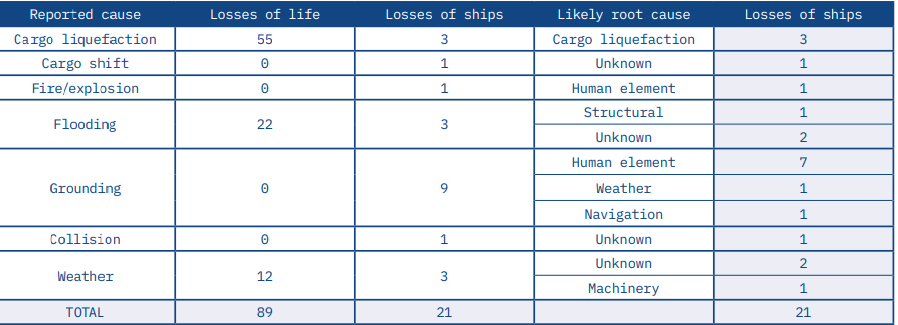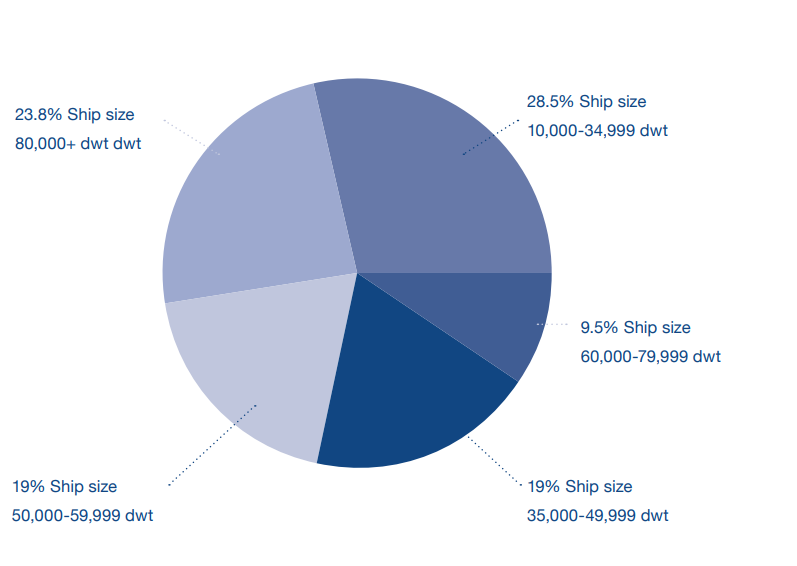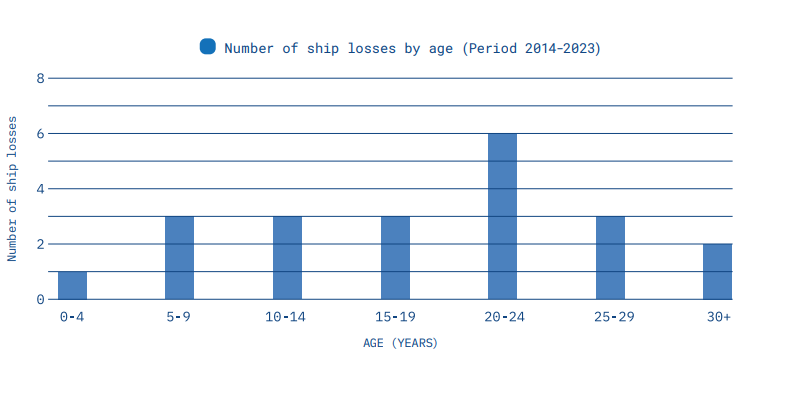INTERCARGO published its Bulk Carrier Casualty Report, reporting that 21 bulk carriers of more than 10,000 deadweight tonnes (dwt) were reported lost, with the tragic loss of 89 seafarers’ lives, for the years 2014-2023.
Ships lost by size
According to INTERCARGO, bulkers losses took place as follows:
- 80,000+ dwt: Six ships were lost, accounting for 23.8% of the total 21 casualties reported. These casualties cost 22 lives, or 24.7% of the total 89 lives lost during the period. In 2020 the losses of one Capesize and one VLOC vessel (Wakashio and Stellar Banner) focused attention on large bulk carrier safety.
- The lowest number of casualties occurred in the 60,000-79,999 dwt range, representing 9.5% of the total of 21 ship losses, with no fatalities. There was no life lost as a consequence of those ship losses.
- Other categories saw the loss of six ships with significant loss of life as a result. The 50,000-59,999 dwt range accounted for 55 seafarers’ lives, (61.8% of the total), and 12 fatalities in the 10,000- 34,999 dwt range.
Losses by cause
- Cargo liquefaction remains the greatest contributor to loss of life, accounting for 55 lives or 61.8% of the total loss of life in the past ten years.
- Groundings remain the greatest cause of ship losses, with nine losses or 42.9% of the total.
- Three casualties (14.3% of the total) were a result of flooding and these cost 22 lives – a significant 24.7% of the total number of lives lost.
- The average life loss per ship casualty was 4.24 during the tenyear period between 2014 and 2023, and 4.00 between 2013 and 2022, 3.41 between 2012 and 2021. This compares to 3.56 during 2011 and 2020.

Losses by bulk carrier size

Number of losses by age

Naturally, areas of concern remain including cargo liquefaction or other moisture related cargo failure mechanisms, which pose the greatest risk to life, contributing to the loss of 55 lives or 61.8% of the total loss of life over the past 10 years. Groundings remain the biggest cause of ship losses. Enhancement of safety awareness by all parties, and especially the need for stakeholders to provide ships’ crews with the correct cargo characteristics details, remains a priority to reduce casualties even further.
The reduction of incidents, as revealed in the Report, can be attributed to continual safety improvements implemented by ship operators in tandem with enhanced legislation within the sector. A significant contributing factor to the safety performance of bulk carriers is the development and implementation of an improved international regulatory framework. As a Non-Governmental Organisation (NGO) within the International Maritime Organization (IMO), INTERCARGO is proud to have played an important part in the development of this legislation. The adoption of new technology to improve ship design is also a major causal factor.
Bulk carrier safety must never be overlooked. We have come a long way since the ‘dark days’ of the 1980s, when we experienced many tragic losses of lives and vessels. Since then, safety performance of the sector has steadily improved, thanks in large part to concerted efforts by INTERCARGO with other industry stakeholders. These latest statistics reveal an impressive achievement, especially when considering the significant rise in the number of bulk carriers during this period.
..Dimitris Fafalios, INTERCARGO Chairman, commented.
“There is, however, definitely no room for complacency. Any loss of life is tragic, and the shipping industry must pay close attention to the contributing causes analysed in this report. INTERCARGO believes the dry bulk sector should be proud of its achievement and recognise that improved safety is largely thanks to continuous crew and shore-staff training, improved ship design, new technology and stronger regulatory compliance,” Fafalios said.
































































